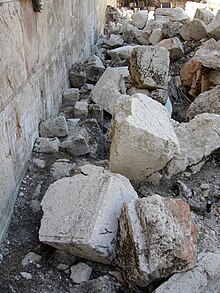DISTRUCTION OF JERUSALEM TEMPLE
"Destruction of Jerusalem" redirects here. For the destruction under Nebuchadnezzar, see Siege of Jerusalem (587 BC).
The account of Josephus described Titus as moderate in his approach and, after conferring with others, ordering that the thousand-year-old (at that time) Temple be spared. (Solomon's Templedated to the 10th century BC, though the physical structure was Herod's Temple, about 90 years old at the time.) According to Josephus, the Roman soldiers grew furious with Jewish attacks and tactics and, against Titus' orders, set fire to an apartment adjacent to the Temple, which soon spread all throughout. However, Josephus may have written this in order to appease his coreligionists.
Josephus had acted as a mediator for the Romans and, when negotiations failed, witnessed the siege and aftermath. He wrote:
Now as soon as the army had no more people to slay or to plunder, because there remained none to be the objects of their fury (for they would not have spared any, had there remained any other work to be done), [Titus] Caesar gave orders that they should now demolish the entire city and Temple, but should leave as many of the towers standing as they were of the greatest eminence; that is, Phasaelus, and Hippicus, and Mariamne; and so much of the wall enclosed the city on the west side. This wall was spared, in order to afford a camp for such as were to lie in garrison [in the Upper City], as were the towers [the three forts] also spared, in order to demonstrate to posterity what kind of city it was, and how well fortified, which the Roman valor had subdued; but for all the rest of the wall [surrounding Jerusalem], it was so thoroughly laid even with the ground by those that dug it up to the foundation, that there was left nothing to make those that came thither believe it [Jerusalem] had ever been inhabited. This was the end which Jerusalem came to by the madness of those that were for innovations; a city otherwise of great magnificence, and of mighty fame among all mankind.
And truly, the very view itself was a melancholy thing; for those places which were adorned with trees and pleasant gardens, were now become desolate country every way, and its trees were all cut down. Nor could any foreigner that had formerly seen Judaea and the most beautiful suburbs of the city, and now saw it as a desert, but lament and mourn sadly at so great a change. For the war had laid all signs of beauty quite waste. Nor had anyone who had known the place before, had come on a sudden to it now, would he have known it again. But though he [a foreigner] were at the city itself, yet would he have inquired for it.
Josephus claims that 1,100,000 people were killed during the siege, of which a majority were Jewish, and that 97,000 were captured and enslaved, including Simon bar Giora and John of Giscala.
"The slaughter within was even more dreadful than the spectacle from without. Men and women, old and young, insurgents and priests, those who fought and those who entreated mercy, were hewn down in indiscriminate carnage. The number of the slain exceeded that of the slayers. The legionaries had to clamber over heaps of dead to carry on the work of extermination."
Many fled to areas around the Mediterranean. Titus reportedly refused to accept a wreath of victory, saying that the victory did not come through his own efforts but that he had merely served as an instrument of God's wrath.





Comments
Post a Comment